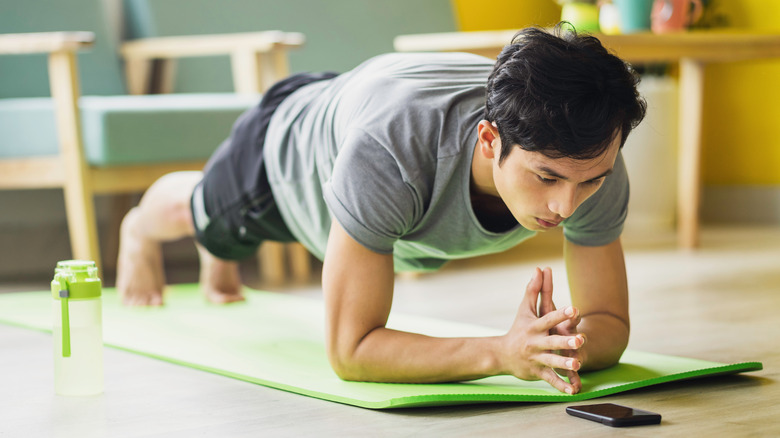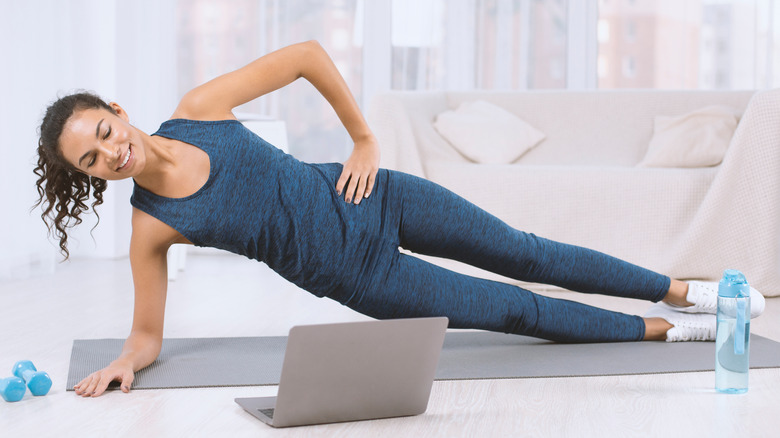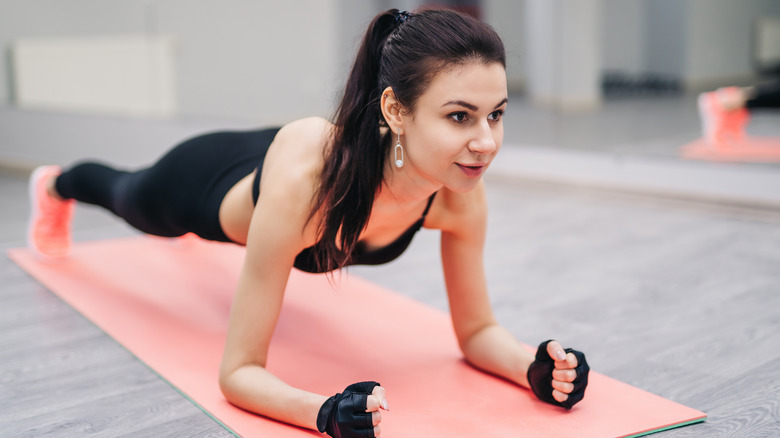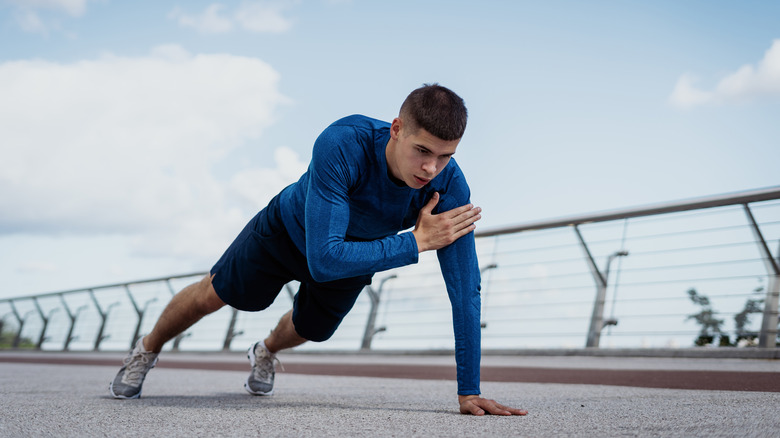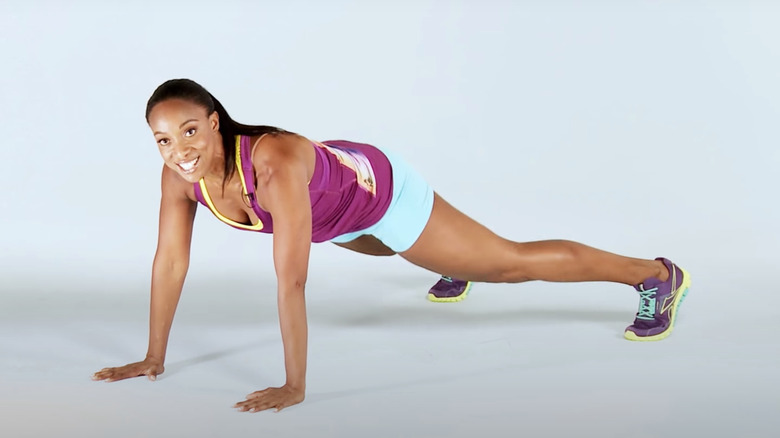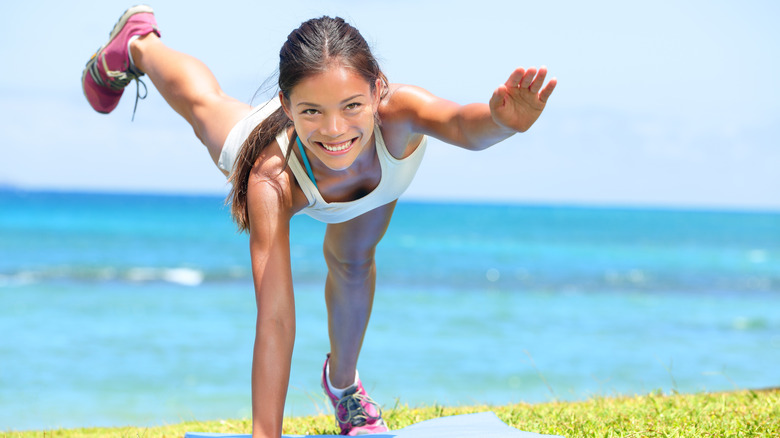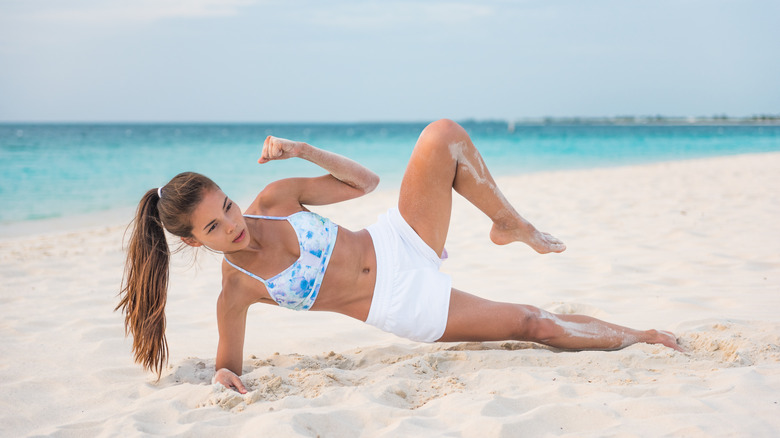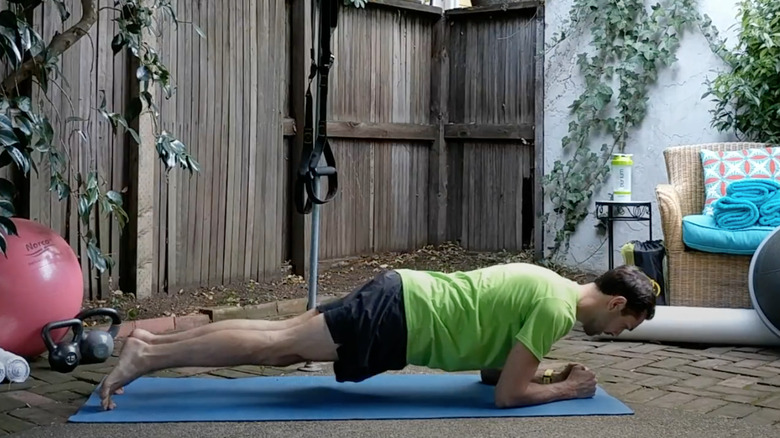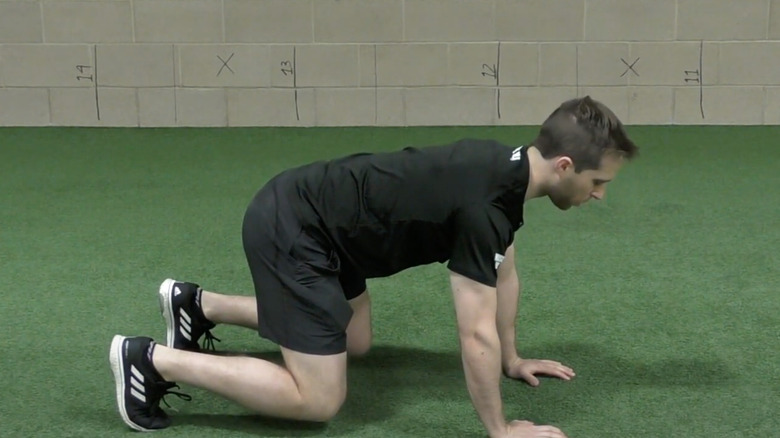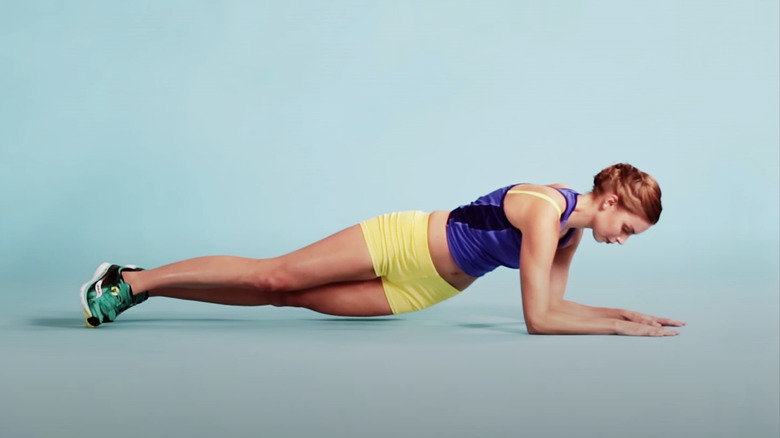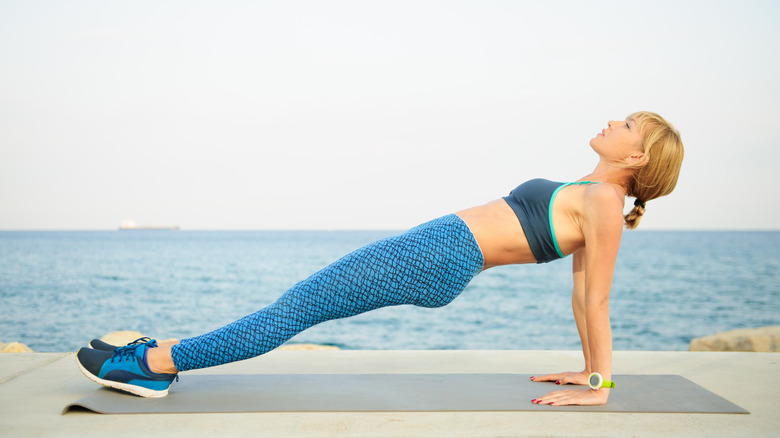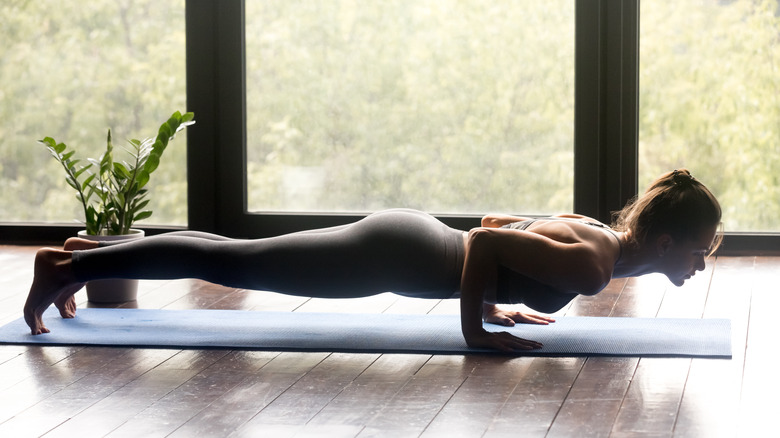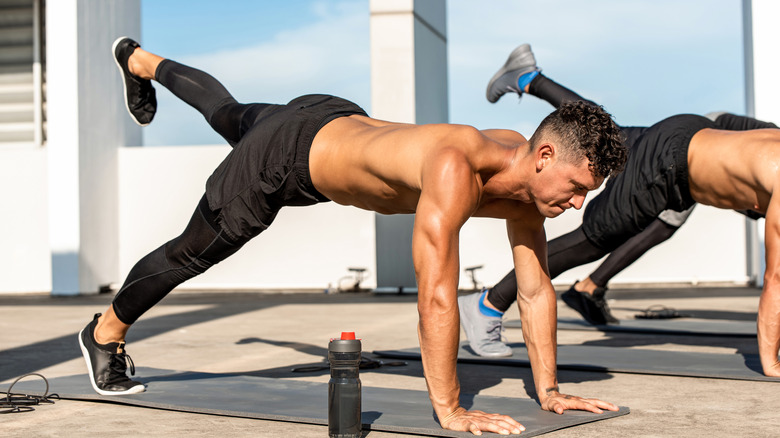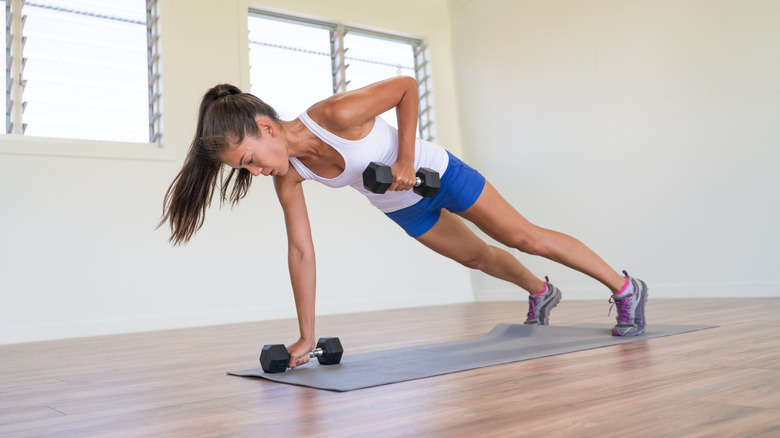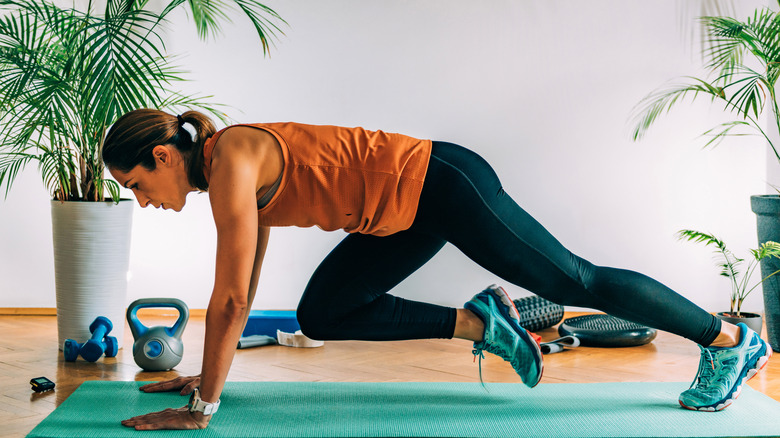Plank Exercises You Should Be Doing
In the hallowed halls of classic exercise moves, the plank sits on the throne. Anyone who's done a plank knows that the seemingly simple move will have you sweating in no time, and the benefits that planks supply to your fitness, through the engagement of your abdominals, back muscles, hips, shoulders, quads, and glutes mean that it's a go-to exercise for personal trainers, according to Prevention. As superstar trainer Jillian Michaels said, "The versatility and accessibility [of the plank] makes it one of the most incredible, well-rounded core exercises" (via Insider).
And, versatile it is, indeed. The plank is almost infinitely adaptable, and a quick Google search will pull up endless results for plank variations to fire up your body. We're not gonna lie — the amount of them can be a little overwhelming at times: one article, for example, offers 49 plank variations. But, where do you begin? The plank needn't be something that requires years of fitness experience to mix up, and some of the best variations come from super-simple adjustments that'll make an already effective exercise even better. So, here at Health Digest, we've put together our very favorite plank exercises you should be doing — and we guarantee they won't take a physiology degree to figure out.
Side planks get your obliques going
So many core exercises out there focus on getting your six-pack ripped, but a strong center is nothing without the obliques. The oblique muscles play an essential role in the strength of our torso and its twisting and bending functions, according to MedicineNet. Side planks, then, are the perfect move for this pair of muscles, as they're "all about strengthening the side body and stabilizing your spine," as certified strength and conditioning specialist and Club Pilates master trainer, Cara Bonney, stated to Women's Health.
Performing a side plank is as simple as a regular plank. Start lying on your side, with your legs extended straight, and your elbow lined under your shoulder with your forearm flat, extending at a 90-degree angle from your body. Lift your hips off of the ground, engaging your core while you do so until your body's in a straight line from the top of your head to your feet (your feet can either be stacked on top of each other, or both on the floor with one in front of the other, depending on what's more comfortable). Hold for 15 to 30 seconds, with your upper hand either resting on your hip or reaching up to the sky. The longer you hold, the more challenging it will be!
The walking plank helps get your cardio in
This plank variation is a little more challenging, but trust us when we say it's one worth mastering. The walking plank is "a great way to work your core and your shoulders," according to SLT trainer Pamela Trujillo (via Well+Good), and not only that but increasing the speed at which you do it can get your heart rate up, making it a cardio exercise as well as a muscle strengthener.
Begin in a forearm plank, making sure your body is correctly aligned from your head to your feet, said Coach. Take one hand, and push up, letting the other join in the movement, until you're in an elevated push-up or standard plank position. Then, lower yourself back into a forearm plank, again one hand at a time. Try to continue this movement for around a minute at a time and, once you've mastered the form, you can speed it up to get your heart rate going. Make sure your plank is controlled while you do so. As Trujillo said, "Your hips are going to naturally move a little bit with this one, but you're going to want to keep them as still as possible."
Plank shoulder taps challenge your balance
A simple movement during a standard plank can produce enormous results for your fitness, and that's certainly the case with plank shoulder taps, a simple variation that challenges your shoulders and arms as well as your core, as Coach stated. In addition, the movement that the taps generate keeps the challenge to your core varied, meaning they're working more. And, aside from these, it just keeps things a little more interesting than a normal plank!
To do plank shoulder taps, start in an elevated, standard plank, with your arms stacked directly under your shoulders and your body aligned from your head to your feet. Slowly take one hand off the floor, and bring it up to tap your opposite shoulder, trying to keep your shoulders and hips steady as you do so. Place the hand used to tap back down on the floor in the original position, and repeat with the opposite arm. Keep going for around 30 to 60 seconds, or so. If you're finding the stability a little tricky, keep working on your standard plank form for a while before attempting it; or, a neat trick is to imagine that there's a glass of water resting on your lower back, that you need to keep steady as you move.
Plank jacks are an intense, high-energy plank variation
This surprisingly intense variation will get your heart racing in no time, while also providing a huge challenge to your abs, upper body muscles, and legs, said Byrdie. Think of it as a jumping jack/plank combo: in a standard plank with your arms stacked under your shoulders and hands placed firmly on the floor, engage your core and jump your legs out to either side, as though you were doing the lower half of a jumping jack. Try not to let your hips elevate too much as you do so. Then, jump your legs back in, repeating the movement for 20 to 30 seconds.
This plank variation can be surprisingly intense so, if you're finding it a little tricky to start, "reduce the intensity by simply stepping it out rather than jumping, moving one leg out and in, and then alternating with the other side," recommended bande instructor Mindy Lai. Plank jacks can also place a large strain on your wrists. "Another modification," stated yoga teacher Dani Schenone, "is to perform plank jacks on the forearms to protect the wrists and elbows, and to support the longevity of your workout routine."
Feel like a superhero with Superman planks
Enough planks will have you feeling like a superhero eventually, but you can get there a little quicker with a Superman plank. Like many plank variations, the Superman plank kicks up the intensity of a regular plank by requiring you to stabilize your body while moving your limbs, simultaneously providing a challenge to your balance, as Coach advised.
To do the move, put your cape on (just kidding!) and get yourself into a standard plank position. Make sure your body is properly aligned and, while holding the plank position, slowly lift one arm up and forward from your body (think of Superman flying), while the opposite leg slowly lifts from the floor and extends to the back. Hold the position, if you can, for five seconds or so, and then slowly lower your arm and leg back to the floor. Repeat on the other side.
This move is a serious challenge to balance and strength, so it helps to build up to it. Try performing the exercise on your hands and knees to start, to get used to the movement and build up strength. It also benefits to work on your standard plank without any movement for a while before going all superhero.
Side plank crunches are great for oblique strength
If you really want to kick it to your obliques, it's time to take side planks up a notch. This move will help you target your obliques and your hip muscles, while also providing a challenge to the rest of your body, according to Greatist.
Begin in a standard forearm side plank, making sure that there's alignment throughout your body. Your feet can either be stacked on top of each other or placed one in front of the other on the floor. Place your upper arm with your hand behind your head, and then slowly take the knee of the upper leg and bring it to meet the elbow of your top arm, in a crunch movement. Try and keep your body as steady as possible while you do this. Return to the starting position, and repeat for five to 10 reps, for three sets, resting in between them. Repeat on the other side.
To modify it to make it easier, instead of doing these in a full side plank, place your knee and hand on the floor. If you want to kick up the intensity, you could perform this move with a weight in hand.
Rocking planks helps work all your smaller muscles
This isn't just a plank variation that's set to a Slayer soundtrack (although if you want to really take your exercise to the next level...). The rocking plank uses a simple movement of rocking back and forth to provide a test to your ab muscles that a standard plank doesn't, stated Self. In addition to this, "It also targets the accessory [or smaller] muscles that sometimes take a back seat when you do other shoulder-focused exercises, like a shoulder press," stated yoga instructor and LA-based trainer, Alexis Novak.
This move is also super simple. Begin in a forearm plank, making sure your arms are aligned properly underneath your shoulders. Gently rock your entire body forward so that your shoulders come past your elbows and your feet come onto your toes more, keeping your hips raised and your core engaged. Rock back to the starting position, and repeat this motion for 15 to 30 seconds, for three to five sets. Novak has a top tip about a variation that can ease your form here: try facing your palms upwards instead of down, to "[create] space for the bone, joints, and surrounding fascia to glide more effortlessly."
Bear planks go easy on the lower back
Sometimes, a little change in form is all we need to revolutionize an exercise. This is the case with bear planks, a plank variation that's particularly good at targeting your lower abdominal muscles, as Verywell Fit stated. Bear planks are also much easier on the lower back than regular planks can be, meaning they're a great choice for people who experience lower-back pain or tension.
Begin in a tabletop position, with your arms stacked under your shoulders and your knees in line with your hips. Make sure your back is flat (engaging your core will help to naturally flatten the back), and using the tops of your feet and your palms, slowly lift your knees three to six inches from the ground, with your hips and shoulders level. Hold the position for between 30 to 60 seconds, depending on your comfort level, breathing throughout, and keeping your core engaged. Slowly lower your knees to the floor to rest, and repeat after a short break. The key here is to try not to collapse your lower back while you're performing the move, by keeping your core engaged. In addition, keep your gaze looking down to the floor throughout, as this keeps your neck in a neutral position.
Watch your neck when doing plank hip drops
Plank hip drops are a great way to turn a static exercise like a plank into something much more dynamic. Additionally, they really hit your obliques, as well as your lower back through the movement of the exercise, as Exercise.com stated. Begin in a forearm plank, remembering, as always, to make sure that your core is engaged, your arms are perpendicular to both the floor and your shoulders, and that there's a straight line running from your head to your feet. Slowly rotate at the waist, and lower your right hip to the ground, touching it to the floor. Rotate back up to your starting position, and then repeat the exercise on the other side.
As Spotebi points out, it's important to remember to breathe during this exercise, and to challenge yourself by dipping as low as you can without compromising your form. Try, as well, to not let tension creep up into your neck and, instead, keep your gaze focused down and your neck free to avoid any unnecessary crunching. With any plank exercise, in fact, you should "draw the chin slightly back, keep eyes down, and keep the back of the neck long and in line with the rest of the spine," said Fhitting Room NYC trainer, Chelsea Aguiar, to Prevention.
Reverse planks are awesome for your glutes
A plank... but in reverse (insert the "mind-blown" emoji here). While this move might bring back memories of shuffling around the playground pretending to be a crab, it's actually an all-over body burner that targets your core, your arms, and is particularly great for your butt muscles, according to Women's Health.
Begin this move by sitting on the ground (easy, right?) with your legs extended in front of you, and your hands behind your back propping you up, fingers pointing towards your body. Making sure your legs are aligned with your shoulders, push yourself up, with your body either in a straight line or with your feet moved slightly back and your knees bent to make it easier. Once your body is fully elevated, hold for 20 to 30 seconds, and then rest. If that's a little challenging, you can start with shorter bursts of reverse planks to build up. It's also worth pointing out that for this move, "you need strength in both your upper and lower body," as "Weight Training Without Injury" author and exercise physiologist, Rachel Straub, said. So, if you're finding it super hard, spend some time working on your upper body and lower body strength first.
Chaturanga Dandasana (or low plank) challenges your upper body
Chaturanga Dandasana is a plank variation that'll set your arms on fire. A staple of yoga workouts, and also known as a low plank, it's a seemingly simple move, but making sure your form is on-point is crucial to avoiding injury, reported Verywell Fit.
Start in a standard plank, with your shoulders over your wrists and both your arms and your knees straight. Pull your belly button in to meet your spine to keep your core engaged. Slowly shift the plank forward so your shoulders move slightly further forward than your wrists. Roll your shoulders back and, hugging your elbows into your body (as opposed to letting them flare out, like in a push-up), bend your arms slowly, lowering down so that your body becomes parallel to the floor.
Then? Hold. You'll quickly feel how challenging this move is for your upper body and abs, so hold for as long as it's comfortable, and either finish with an upward-facing dog or by pushing up to the starting position. If this move is too challenging to begin, you can also perform it with your knees on the ground.
Plank leg raises incorporate your lower body
Plank leg raises take a plank and, by adding a simple move, add a further challenge not only your abs, but your glutes too, according to Greatist. In this move, you'll start in a standard plank, making sure that your body is properly aligned and that your hands are shoulder-width apart. Slowly raise one of your legs off the ground behind you, keeping it straight, until it reaches hip height. There's no need to point your toe here — your foot can remain flexed.
Pause in this position and then slowly lower your leg to the ground. Repeat with the other leg; one raise on each side is one rep. Ideally, you'll want to go for three sets of 10 reps but, naturally, if this is a little challenging, start small and work your way up. Try and avoid letting your hips sag while you do this move (or piking your body and letting your butt jut up into the air); keeping everything controlled will make your exercise the most effective. You can also turn this into a Superman plank by raising an opposing arm at the same time as the leg raise.
Renegade rows will get your back burning
Ready to get serious? Renegade rows are a next-level, compound plank variation, combining a row and a plank to get your upper body in the best shape of its life. "The row will work your back and turn the plank into an anti-rotational exercise," said Redefining Strength founder and OC-based personal trainer, Cori Lefkowith, to Self. And, it's not just your front abs that'll see the benefit. "Moves like this really work those obliques as well," Lefkowith added.
You'll need some weights for this exercise — ideally a pair of 10- to 15-pound dumbbells. Holding the weights, get yourself into a standard plank, with your hips elevated and your hands a little closer than you would normally have them for stability. Pull one arm up from the ground in a controlled rowing motion, with your elbow going past your chest, and then slowly lower your hand back to the ground. Try not to twist your hips as you do this, and power through your back as you pull the weight up to make sure your back muscles are activated. Repeat on the other side, for six to eight reps per side.
Mountain climbers can be a cardio exercise or a pure muscle strengthener
It wouldn't be an article on planks without mountain climbers showing up somewhere. Sorry, folks. We know they're not the most fun exercise out there but, honestly, mountain climbers are a plank variation that gives your abs an incredible workout. And, what's more, you can vary the speed to your liking, changing the quality of the move: take it faster, and it's a HIIT exercise, and slower and steadier gives your ab muscles greater focus, as Coach indicated.
Start in a standard plank position, with your legs fully extended and your arms straight. Making sure your body doesn't bend and keeping your core engaged, bend one knee and bring it towards your chest, then return it to the original position. Do the same with the other leg. If you start picking up the pace here, your form can start to suffer a little, so even if you're doing it to get your blood pumping, make sure to keep your core engaged and your body as static as possible. If you really want to raise the game, try wall mountain climbers: instead of putting your feet on the floor, prop them up against a wall. This variation will get your upper body burning in no time.

